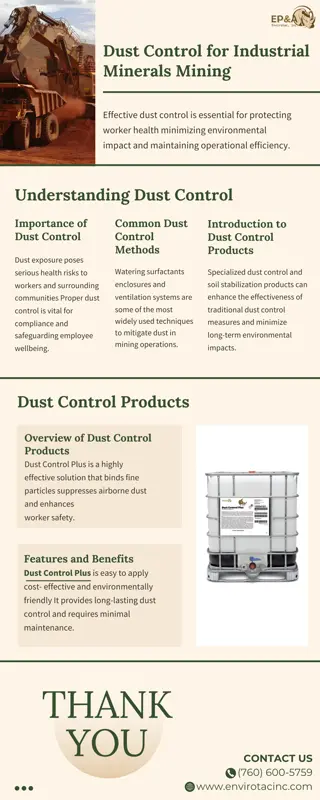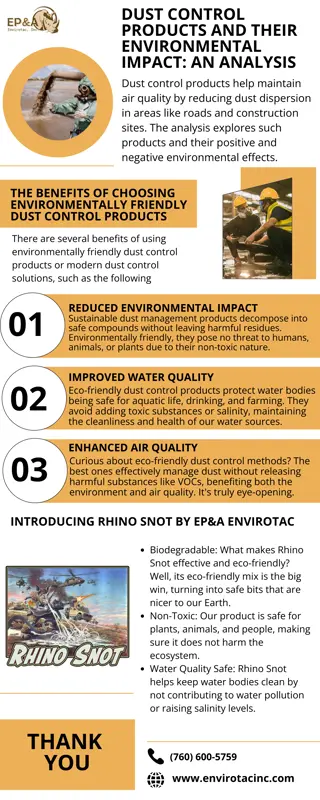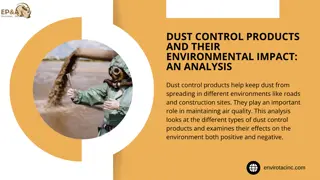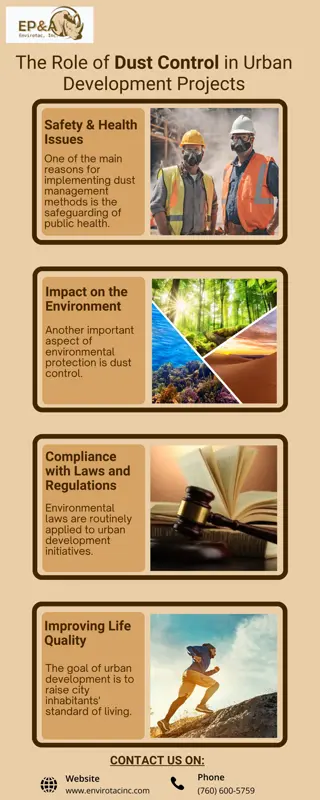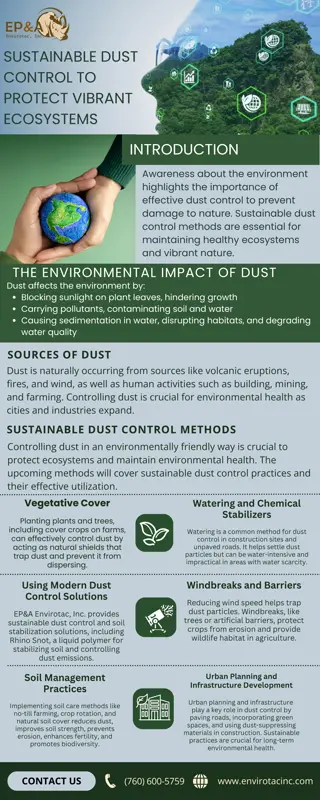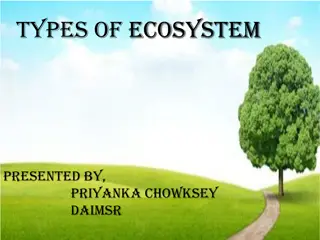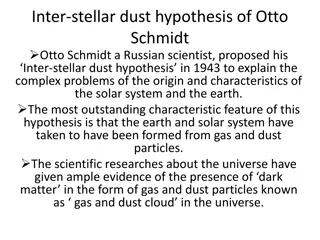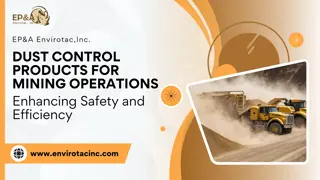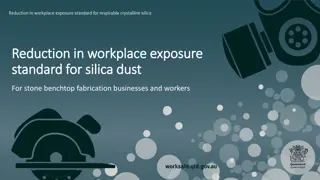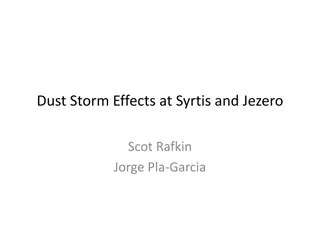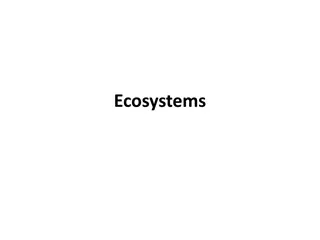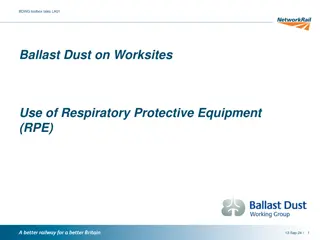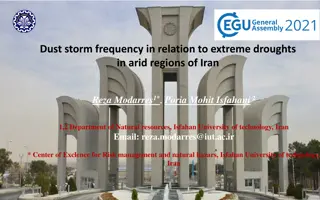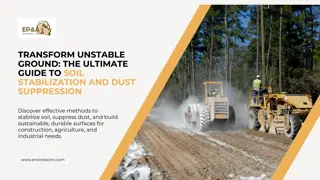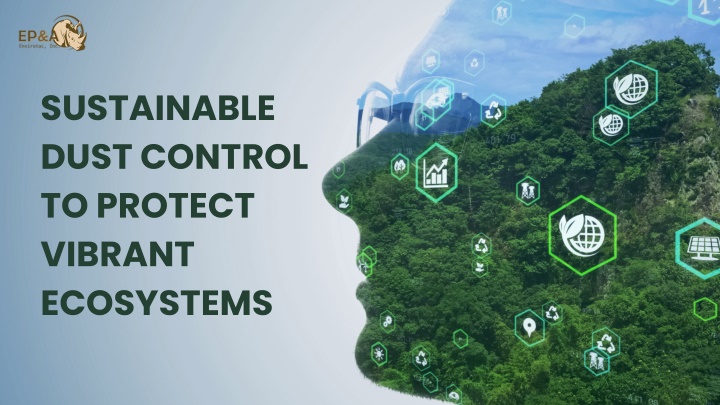
Sustainable Dust Control to Protect Vibrant Ecosystems
With the growing awareness about the environment, dust control naturally assumes a viable position. Dust may appear as a small problem, but at times, it does have the potential to cause enormous damage to nature. Effective dust control is important for keeping ecosystems healthy. This article explores the significance of sustainable dust control and examines methods to ensure that nature remains healthy and vibrant.n
Download Presentation

Please find below an Image/Link to download the presentation.
The content on the website is provided AS IS for your information and personal use only. It may not be sold, licensed, or shared on other websites without obtaining consent from the author. If you encounter any issues during the download, it is possible that the publisher has removed the file from their server.
You are allowed to download the files provided on this website for personal or commercial use, subject to the condition that they are used lawfully. All files are the property of their respective owners.
The content on the website is provided AS IS for your information and personal use only. It may not be sold, licensed, or shared on other websites without obtaining consent from the author.
E N D
Presentation Transcript
SUSTAINABLE DUST CONTROL TO PROTECT VIBRANT ECOSYSTEMS
INTRODUCTION With the growing awareness about the environment, dust control naturally assumes a viable position. Dust may appear as a small problem, but at times, it does have the potential to cause enormous damage to nature. Effective dust control is important for keeping ecosystems healthy. This article explores the significance of sustainable dust control and examines methods to ensure that nature remains healthy and vibrant. Learn and Act Lecture Series: Orcas
THE ENVIRONMENTAL IMPACT OF DUST Dust impacts the environment by blocking sunlight on plant leaves, hindering growth and affecting animals relying on these plants. It carries pollutants, contaminating soil and water. In water, dust causes sedimentation, disrupting aquatic habitats and degrading water quality, making it unsuitable for wildlife and human use.
SOURCES OF DUST Dust is both naturally caused by volcanic eruptions, fires, and wind over dry regions, and is created through the activities of people. Building, mining, farming, and dirt roads are the key sources. As cities and industries grow, it's really important to find ways to control dust to keep our environment healthy. SUSTAINABLE DUST CONTROL METHODS Using methods to control dust in a way that's good for the environment is important. It helps reduce how much dust affects ecosystems, making sure nature stays healthy. The following methods in the next slide discuss the importance of sustainable dust control and how to use them effectively.
Watering and Chemical Stabilizers Using Modern Dust Control Solutions Windbreaks and Barriers Vegetative Cover One of the best ways to control dust is by planting plants and trees. They work like natural shields, catching dust and keeping it from flying around. On farms, planting cover crops can stop soil from washing away and making dust. Watering is a common dust control method, especially in construction sites and unpaved roads. Also, the dust particles may be kept settled on the ground with regular watering. That is a water-intensive process and requires sustained effort; therefore, in many cases, it might not be viable, especially in those regions where accessibility or shortage of water is a problem. Companies like EP&A Envirotac, Inc. offer innovative dust control solutions and soil stabilization methods that exemplify sustainable practices. Their product, Rhino Snot, is a liquid polymer that effectively stabilizes soil and controls dust emissions It involves reducing wind speed, thereby reducing its speed and trapping dust particles. They may be either natural windbreaks one line of trees or artificial ones, like fences and walls. Windbreaks perform well within the agricultural setting where crops get protection from wind- caused erosion and habitat for wildlife.
Soil Management Practices Urban Planning and Infrastructure Development Using better ways to take care of soil can greatly lessen dust. Methods like no-till farming, crop rotation, and using natural materials to cover soil help keep it strong and stop it from washing away. These methods not only cut down on dust but also make the soil fertile and help enhance biodiversity. Proper urban planning and infrastructure are crucial for dust control. Paving roads, creating green spaces, and using dust- suppressing materials in construction reduce dust pollution. Urban planners and developers should prioritize sustainable practices to ensure long-term environmental health.
The Value of Collective Action in Dust Control Effective dust control requires collaboration among governments, businesses, and communities. Strict laws and regulations are essential for environmentally friendly dust management in construction, mining, and agriculture. Governments should support innovative dust control methods. Public awareness and community involvement, such as tree planting and sustainable farming, are crucial for lasting environmental sustainability.
The future of dust control lies in using eco-friendly methods and ensuring long-term environmental care. New technologies and increased environmental awareness offer better dust control options, such as plant-based dust blockers, advanced monitoring, and climate-resilient vegetation. Integrating dust control into broader conservation plans leads to lasting improvements. The Future of Sustainable Dust Control Scientists, government leaders, and communities must collaborate to develop and implement innovative dust control solutions. As we understand dust's environmental impact better, it's crucial to enhance our strategies. Companies like EP&A Envirotac, Inc. contribute significantly by creating eco-friendly dust control products, highlighting the importance of sustainable practices for long-term ecological health.
THANK YOU CONTACT US (760) 600-5759 www.envirotacinc.com




